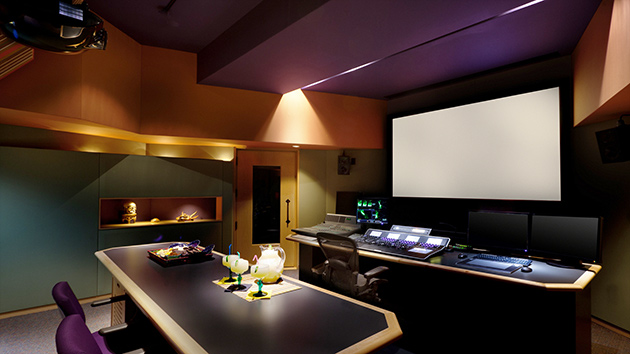Longtime Audio Post House Now a One-Stop Shop for Sound and Picture
Audio post house Margarita Mix Hollywood, which recently added two color suites and an upgraded media-management hub, is the first FotoKem facility to fully integrate GlobalData, the company's international network for intercontinental data delivery. Officials say that significantly expands the range of services Margarita Mix can offer for productions looking to extend the speed and flexibility of tapeless post workflows.
"Our regular clients had always asked for a seamless way of working — a one-stop facility — and we could never provide that" until FotoKem purchased Margarita Mix in the fall of 2011, explained Margarita Mix General Manager Veneta Butler. "[FotoKem] put that vision into play. We started with one color bay and one editor, and from the day we opened that up, October 15, 2011, we stayed busy. We had to open a second bay pretty quickly for color grading."
Margarita Mix chose Nucoda Film Master for its color suites mainly because FotoKem was already using the system and found it to integrate well with Avid systems. "If we're working in the Avid and I'm waiting for graphics and titles, it comes in via GlobalData and we import it directly into the Avid," Butler says.
Clients for Margarita Mix's color services include Ridiculousness and Fantasy Factory, airing on MTV, Top Gear U.S.A., airing on History, Breaking Point on The CW, The Glee Project on Oxygen, and Richard Hammond's Crash Course on BBC America.
FotoKem Senior VP Rand Gladden told StudioDaily that the capabilities of the GlobalData network are logical extensions of the now-complete move to tapeless workflows in post-production. FotoKem has hooked up all of its post facilities to the network with either 1 Gig or, mostly, 10 Gig connections. "It enables [clients] to put original content on NAS storage in any given building they're working in where we provide the production and post-production environment," Gladden said. "We can hit those master NAS systems and do finishing work, online editing, sound work, and so forth much quicker.
"In the past, all that material had to be moved on tape or on hard drives, and then we had to ingest all of that data or video before going through and accessing just the shots and pieces we needed for the edited piece. Now, we hit the master material [via the network] and a 10- to 12-hour online on a one-hour show can happen in less than an hour. Additionally, it enables all of the people on a show, from offline creating to online final finishing and sound design, to have access to the original material simultaneously. That's unique, and it hasn't been done in the past — not for multiple shows and multiple locations."
Because of the speed of the network, there are no limits on the quality of material that it can transfer. Because Margarita Mix handles a lot of reality television programming, much of the content being worked on does happen to be in highly compressed formats, but all of the files are at the full resolution recorded by the camera. "You can shoot ARRIRAW or 4K files and work with them, too," Gladden said.
Gladden said Margarita Mix is the first FotoKem facility to "fully integrate" the process as a "one-stop shop," noting that it makes revisions much easier and allows online work to proceed while offline editing is still taking place. But other FotoKem locations are making use of the network. "On our shows for Dick Wolfe [including Chicago Fire, Chicago PD, and Law and Order: SVU] they use [FotoKem's mobile dailies system] NextLab to do dailies in the cutting room, and the original media sits on that server," Gladden explains. "When they turn over a show, those shots get sent to us over the network, directly to the effects department, by the assistant editors. We do the effects and send them back through the network. There is no more confusion of pulling plates, giving them counts, and all that. We just go right into the media."
The real benefits come when clients want to push the envelope and keep working creatively as the online process proceeds, and the network connectivity makes it easy to keep all of the departments in sync as changes happen. "Everyone wants to keep editing until two days past the deadline," Gladden said. "We have situations where we'll be finishing a version while [the client is] still creatively editing. Instead of throwing our work away and starting over, we can go into their bin to retrieve the most recent version of the cut, identify the changes, and ripple those through picture and audio. So once they hand over the first cut, we can start sound design and editorial while they're finishing up the creative. A day or two days later, they'll hand over the final version and then we'll make final versions. We can start the process sooner, and we have the ability to efficiently make changes in the masters."
Crafts: Post/Finishing
Sections: Technology
Did you enjoy this article? Sign up to receive the StudioDaily Fix eletter containing the latest stories, including news, videos, interviews, reviews and more.











There is no such thing as an ArriRaw 4K file, because Arri does not make a 4K camera. The Alexa Raw resolution is a maximum of 2880×2160, and that is on the 4:3 sensor. The Alexa series is generally considered a 2K camera.
Right you are. This was a transcription error in which the key conjunction “or” was missing from Gladden’s quote. Fixed!